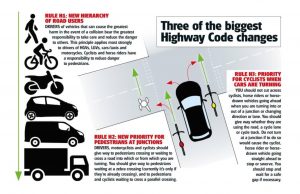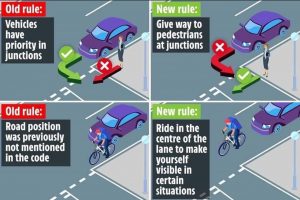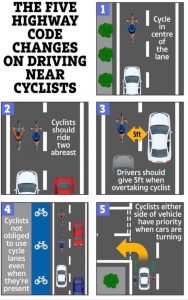Highway Code changes – Junctions and Cyclists
Highway Code changes – Part 2
Further to our first blog post on the changes to the Highway Code this post covers two of the main changes – junctions and cyclists.
Junctions
The changes to the Highway Code have placed the ‘Hierarchy of Road Users’ at the heart of the changes. This means that the most vulnerable road uses – pedestrians – are at the top as they are the most vulnerable and those in charge of vehicles that can cause the greatest harm have the greatest responsibility to take care and reduce the danger on the road. However, this does not mean that pedestrians should now just assume they have priority at every junction!

The biggest change is “at a junction you should give way to people crossing or waiting to cross a road into which or from you are turning.”
There is a lot of controversy over this. For instance the Automobile Association (AA) has expressed concern about the possibility of an increase in rear-end shunts. Drivers and motorcyclists in particular need to be aware of the new requirement. This includes being aware of:
- the actions of the person crossing
- the actions of other road users nearby.
If someone is standing near a junction it can sometimes be difficult to work out what their intention is. Are they looking to cross or just chatting to someone – or on their phone. Hopefully if they are intending to cross they will be looking in the direction of the traffic – but I’m sure we have all come across someone who just steps our into the road without looking. There may be a hierarchy of road users but every level has a responsibility to act safely. You cannot assume just because you are a pedestrian and at the top of the hierarchy that everyone else is automatically going to stop for you.

If you are driving or riding a motor bike you need to be aware of the person who appears to be intending to cross and plan your approach accordingly. The amended Highway Code says ‘should’ not ‘must’!
Cyclists and horse riders
The updates for cyclists includes:
- riding in the centre of their lane on quiet roads, in slow moving traffic and approaching junctions or where the road narrows
- staying at least 0.5 metres away from the kerb (and more if it is safe to do so)when riding on busier roads
People cycling in groups have often annoyed drivers and the updated code now says:
- they should be considerate of the needs of other road users
- can ride 2 abreast, indeed it is safer to do so
However the code also lays a responsibility on cyclists to be aware of following drivers and allow them to overtake when it is safe to do so.
Overtaking cyclists
Drivers and motor cyclists now have the following guidance form passing vulnerable road users – i.e. pedestrians, cyclists and horse riders:
- leave at least 1.5 metres when overtaking at speeds up to 30mph, more at higher speeds
- pass horses and riders at a minimum of 2 metres ands at a speed less than 10mph
- allow a minimum of 2 metres to pass pedestrians walking in the road when there is no pavement.

The intention of all these changes is to try and make the roads safer and reduce the number of fatalities and serious injuries on the road. There have already been numerous debates and discussions especially surrounding giving way at roundabouts and whether this applies to both approaching and leaving a roundabout. There is currently conflicting information from the DVSA on this! We hope to be able to give a definitive update very soon as we have a Zoom meeting with the local test centre manage this coming Tuesday (February 8th 2022). In the meantime if you have any queries please don’t hesitate to contact us and we will do our best to help you.
